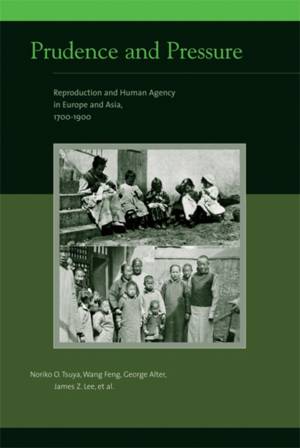
- Afhalen na 1 uur in een winkel met voorraad
- Gratis thuislevering in België vanaf € 30
- Ruim aanbod met 7 miljoen producten
- Afhalen na 1 uur in een winkel met voorraad
- Gratis thuislevering in België vanaf € 30
- Ruim aanbod met 7 miljoen producten
Prudence and Pressure
Reproduction and Human Agency in Europe and Asia, 1700-1900
Noriko O Tsuya, Feng Wang, George Alter, James Z LeeOmschrijving
A study of human reproduction and social organization in preindustrial communities that reveals important similarities between Europe and Asia.
This pioneering study reconceptualizes the impact of social organizations, economic conditions, and human agency on human reproduction in preindustrial communities in Europe and Asia. Unlike previous studies, in which Asia is measured by European standards, Prudence and Pressure develops a Eurasian perspective.
Drawing on rich new data and the tools of event-history analysis, the authors challenge the accepted Eurocentric Malthusian view that attributes "prudence" (smaller families due to late marriage) to the preindustrial West and "pressure" (high mortality due to overpopulation) to the East, showing instead important similarities between Europe and Asia in human motivation and population behavior.
The authors analyze age, gender, family and household, kinship, social class and power, religion, culture, and economic resources in order to compare reproductive strategies and outcomes. They reveal underlying similarities between East and West in two major components of the reproductive regime--marriage and childbearing--and offer evidence showing that preindustrial reproduction was motivated and governed by human agency at least as much as by human biology.
Prudence and Pressure is part of a large-scale interdisciplinary effort to use new data and methods to re-examine the Malthusian paradigm of population growth. It represents a significant advance in the fields of historical demography, history, and sociology.
Specificaties
Betrokkenen
- Auteur(s):
- Uitgeverij:
Inhoud
- Aantal bladzijden:
- 380
- Taal:
- Engels
- Reeks:
Eigenschappen
- Productcode (EAN):
- 9780262013529
- Verschijningsdatum:
- 26/02/2010
- Uitvoering:
- Hardcover
- Formaat:
- Genaaid
- Afmetingen:
- 155 mm x 229 mm
- Gewicht:
- 680 g

Alleen bij Standaard Boekhandel
Beoordelingen
We publiceren alleen reviews die voldoen aan de voorwaarden voor reviews. Bekijk onze voorwaarden voor reviews.









